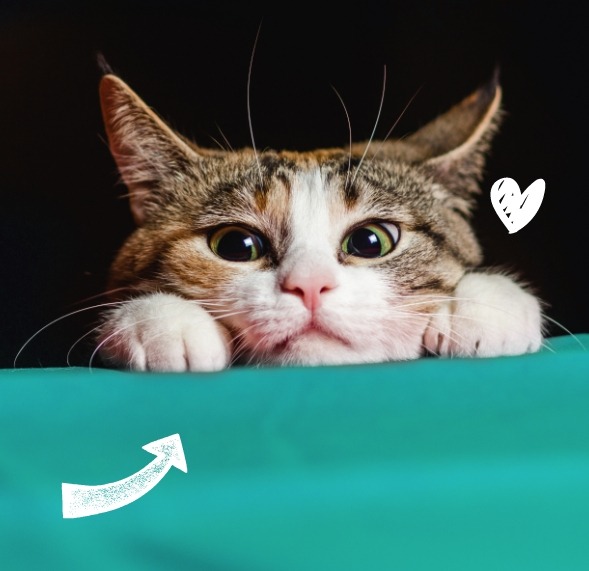
Cats are excellent groomers, so it can be difficult to image your feline friend catching parasites. However, fleas and ticks are two of the most common health concerns cats face. If left untreated, these parasites can cause serious health risks for both pets and humans, so it’s important to learn the signs of infestation and be able to tackle the problem quickly and effectively.
This handy guide looks at how to identify the symptoms of parasites, the best ways to treat fleas and ticks, and how to prevent an infestation, to help you and your feline friend stay happy and healthy.
What are fleas and ticks?
Fleas and ticks are parasites that feed on pets. A cat and dog’s soft, warm fur provides the perfect environment for fleas and ticks to thrive, especially in the warmer months. The most common type of parasite is the cat flea. These wingless insects are dark brown, typically 1-2 mm in length and have an itchy exterior that can trigger an allergic reaction in your cat. Their large size means you can often spot them in carpets or on your pet’s fur, while their six long legs allow them to jump from surface to surface.
Fleas lay 20 to 40 eggs per day over several weeks and live on one host, meaning that they will stay on your cat for the entirety of their 100-day lifespan. To protect your cat from both fleas and ticks, it’s important to understand the differences between the parasites. Ticks are tiny and difficult to spot before they’ve fed, but once they’ve attached themselves to your cat they can swell up to the size of a pea. They are black, brown or tan in colour and tend to feed around a cat’s head and neck. Ticks live from a few weeks to around three years and spend most of their lives living off their host.
They can lie on surfaces for extended periods of time until the right host comes along, feeding on a different animal for the different stages in their development. They are capable of laying thousands of eggs at one time and can survive near-freezing temperatures, but fall off and die soon after giving birth.
What are the symptoms of flea infestation?
The most obvious sign that your cat has fleas is persistent scratching or over-grooming, which can lead to bald patches in fur. If your cat has a flea allergy you may also notice scabs and sore areas on their skin. To check your cat for fleas, run a tight-lipped comb through their fur and wipe the debris onto a damp paper towel. Any small dark specks that leave a stain are an indication that your cat has fleas.
It’s also possible to find out that your pet has fleas by looking out for itchy red bites on your own skin. Only adult fleas bite humans, so it’s important to begin treatment as soon as possible after discovering these marks to prevent further infestation.
What are the symptoms of ticks?
Ticks are large enough to be visible, especially after they’ve fed. They can look like small warts or bumps on your cat’s skin, and on closer inspection you should be able to see their legs. To check for ticks, part your cat’s fur and run your fingers along their skin, feeling for raised lumps or bumps. Tick bites can also cause irritation and redness, which you may be able to see through your cat’s fur.
Treating fleas and ticks
If you suspect your cat has fleas, speak to your vet for information on suitable treatments and be sure to consult them before using any over-the-counter products. Never use a dog flea and tick treatment on your cat, as most contain active ingredients which can be extremely toxic to felines. There is a wide range of parasite treatments available that can be applied directly to your cat’s skin and fur to target the fleas, including powders, sprays and collars, but some are more effective than others.
Shop-bought flea collars aren’t usually as potent as other treatments, as they only target the area around a cat’s neck. More effective collars that are much more friendly to your cat’s skin can be purchased from your vet, and these tend to be much better at dispersing the active ingredient through their body rather than sitting on their neck. However, spot-on treatments are the simplest and most effective method of treating and preventing fleas, as they halt the development of eggs.
Some flea products also kill ticks, while others only provide some protection against them. Never pull a tick out of your cat’s skin, as you may end up leaving the mouthpart behind, which can result in severe inflammation or infection. If your cat removes a tick, check that its head and legs are intact and that there’s nothing left in your cat’s skin. You should always talk to your vet about the best treatment for ticks and leave the removal of these parasites to them.
How to avoid fleas and ticks
Prevention is the most effective treatment when it comes to fleas and ticks. Cats that are kept indoors and are regularly groomed are far less susceptible to parasites, while those in multi-pet households are more likely to be exposed. The best way to prevent ticks is to keep your cat out of habitats where parasites are known to thrive, such as heavily wooded areas or tall grass. If you suspect an animal in your home has fleas or ticks, you should vacuum the house thoroughly, throw away old pet bedding, launder all soft furnishings and ask your vet for further advice.
The Webbox Difference
Here at Webbox, we try to see the world from a pet’s point of view so we can understand what they want, not just what they need. We put all our love, creativity and fun into everything we make, producing nutritional food and balanced treats designed to keep you and your pet happy and healthy. For fantastic food, tasty treats and magical mousse, shop our cat food range today.

Shop for Dogs
Personalise your search:
Shop for Cats
Personalise your search:
Our Most Popular Products

Squeaky Ball

Webbox Naturals Fish & Meat in Jelly Wet Cat Food

Webbox Naturals Tuna Mousse Wet Cat Food

Webbox Naturals Dry Adult Cat with Chicken and Duck Dry Food

Webbox Cat Easter Egg

Webbox Dog Treasure Hunt Eggs

Webbox Lick-e-Lix with Beef Cat Treats

Webbox Lick-e-Lix Liver Sausage & Cat Grass Cat Treats

Webbox Lick-e-Lix Cheese & Taurine Cat Treats

Webbox Lick-e-Lix Chicken Cat Treats

Squeaky Ball

Webbox Naturals Fish & Meat in Jelly Wet Cat Food

Webbox Naturals Tuna Mousse Wet Cat Food

Webbox Naturals Dry Adult Cat with Chicken and Duck Dry Food

Webbox Cat Easter Egg

Webbox Dog Treasure Hunt Eggs

Webbox Lick-e-Lix with Beef Cat Treats

Webbox Lick-e-Lix Liver Sausage & Cat Grass Cat Treats

Webbox Lick-e-Lix Cheese & Taurine Cat Treats

Webbox Lick-e-Lix Chicken Cat Treats
Get the latest tips ‘n’ advice
Want to find out interesting facts and get helpful tips?
Need help choosing the right food?
Try our Pet Food Finder.

 FREE delivery on orders over £40!
FREE delivery on orders over £40!









